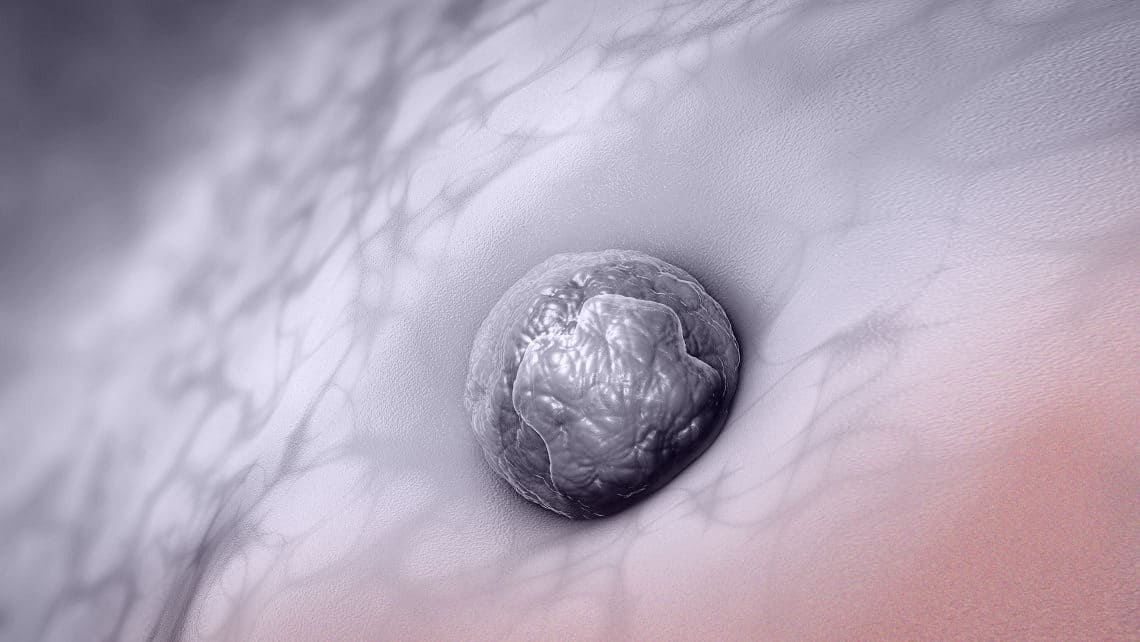
Embryo implantation bleeding
Índice
- 1 What is implantation bleeding?
- 2 When does the embryo implantation happen?
- 3 How does the implantation bleeding happen?
- 4 What happens after 6 to 10 days after fertilization?
- 5 What are the characteristics of implantation bleeding? Colour, quantity and duration
- 6 How to tell the difference between implantation bleeding and menstruation?
- 7 Does this bleeding pose any risk to the pregnancy?
- 8 What should I do if I have implantation bleeding?
- 9 Bleeding after an assisted reproduction treatment
- 10 Reference literature
What is implantation bleeding?
Implantation is the process through which an embryo starts its development in the maternal uterus and it sometimes causes a bleeding. The implantation is caused by the growth of the embryo -which is already in blastocyst stage by the moment it arrives to the endometrium- enabling it to implant in the walls of the uterus, and thus, receive the nutrients from the mother, which will provide it with everything it needs for its development.
The ovulation needs to happen before this union, afterwards, the sperm cell fertilizes the egg in the tube, and finally, the generated embryo reaches the uterus.
The embryo implantation requires a biological complicity between the endometrium (mucous membrane situated in the center of the uterus) and itself. And it doesn’t have much time to do it! Just a few hours in every menstrual cycle, period called “implantation window”.
This is the period in which the endometrium is receptive.
When does the embryo implantation happen?
The embryo has between 12 and 48 hours to do it, between days 20 and 24 of the cycle, -in the case of women with regular periods, every 28 days more or less-.
This date can vary depending on the type of cycle of each woman, whether it is short or long: it happens earlier in short cycles (of less than 25 days), and later in long cycles (of more than 35 days).
How does the implantation bleeding happen?
The implantation process starts 2 or 3 days after the embryo has reached the uterus:
- The cells of the endometrium that make contact with the embryo respond by making a series of complex and diverse changes, including the increase of blood vessels.
- Once the embryo reaches the uterus it continues its “ritual” of implantation phases: apposition, adhesion and invasion.
- In this last phase the embryo enters the endometrium trying to establish a relationship with the maternal blood vessels. This is why it is such a critical and fundamental phase for the implantation to conclude successfully and for the further development of the placenta.
What happens after 6 to 10 days after fertilization?
The endometrium, richly vascularised, has been preparing to receive the embryo and its penetration into the endometrium can cause the rupture of microscopic blood vessels in the wall of the maternal uterus and therefore, vaginal bleeding, which we call “implantation bleeding”, may appear.
According to the statistics, this bleeding appears in less than a third of all early pregnancies.
What are the characteristics of implantation bleeding? Colour, quantity and duration
It is important to note that how it appears and its characteristics may vary:
- The colour may range from brown, pink to even red.
- It may appear together with abdominal discomfort or mild pain similar to menstrual cramps.
- The blood flow may be light or very light.
- Its duration and appearance is also variable. In most of the cases, its duration is short (from 1 to 3 days) and, sometimes, it can even be intermittent lasting for a few days.
How to tell the difference between implantation bleeding and menstruation?
It is not always easy to differentiate them but comparing this bleeding to the characteristics of each woman’s normal period can be helpful.
In general, menstruation is usually heavier, bright red and sometimes accompanied by clots and its duration is similar to a normal period.
In any case, a vaginal bleeding different from the common period, could correspond to an “implantation bleeding”. It may appear before the estimated date of the next menstruation in a natural spontaneous cycle, or before the indicated pregnancy test date after an assisted reproduction treatment (in vitro fertilization, egg donation, insemination, etc.).
Does this bleeding pose any risk to the pregnancy?
Implantation bleeding is the result of the beginning of a pregnancy and as such, it is not considered a pathological event. As mentioned before, it appears in approximately 30% of all early pregnancies and its characteristics may vary.
Therefore it does NOT mean that the pregnancy is at risk. Likewise, if you have experienced it in a previous pregnancy, you should not worry if it does not happen in later pregnancies.
What should I do if I have implantation bleeding?
If this type of bleeding appears in a woman who suspects or thinks she may be pregnant in a spontaneous cycle (i.e. a woman who has not performed any induction of ovulation treatment or an assisted reproduction technique), she can perform a urine pregnancy test on the estimated day/days when her typical menstrual bleeding should have started, which each woman can identify as her usual period, but on this occasion, however, has different characteristics.
If the test is positive, you should contact your medical centre for the correct follow-up of the pregnancy.
Bleeding after an assisted reproduction treatment
If the spotting occurs in a woman who has taken ovulation-inducing drugs (clomiphene citrate or letrozole) or after performing an artificial insemination or in vitro fertilization cycle, she should contact the center where she underwent the treatment.
In these cases, and until you receive the pertinent instructions, you MUST NOT INTERRUPT THE PREVIOUSLY INDICATED MEDICATION. The only definitive test to know whether there has been implantation is a pregnancy test on the date indicated by your center. The presence or absence of bleeding cannot give us a diagnose until that moment.
Reference literature
- Interacción Endometrio Trofoblasto, en la Implantación Humana: Revisión de la Literatura. Ruth Prieto Gómez et al. Int. J. Morphol., 37(2):397-405, 2019.
- Estado actual del conocimiento de la implantación embrionaria humana. Bernabeu R et al. Revista Iberoamericana de Fertilidad. Vol. 21- nº 3 – Mayo-Junio 2004
- Sociedad Española de Ginecología y Obstetricia. Estudio del fallo repetido de implantación y sus posibles alternativas terapéuticas (2017). Prog Obstet Ginecol 2018;61(3):297-311.
Dr. Lydia Luque, gynaecologist at Instituto Bernabeu
